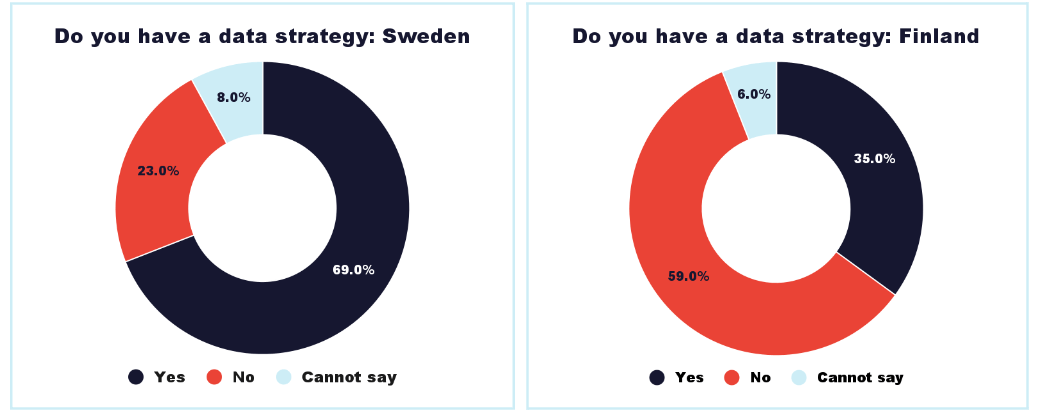
Data strategy obstacles: Three reasons for business-IT misalignment and what you can do about it [2023 AWS and Partner Market Study]
Nordcloud recently collaborated with AWS on a survey of cloud adoption in Finland and Sweden’s private sectors. The survey identified data strategy as a top-of-mind topic for business and IT decision makers in manufacturing, retail and finance companies.
In the survey, respondents answered the question “Do you have a data strategy?” Here were the results:

Many factors can make it difficult for organisations to have a data strategy.
What’s stopping companies from having a data strategy? [Results]
The results identify 4 main obstacles to reaching the data utilisation of industry leaders. They are:
- Knowhow and maturity of the company
- There is a lack of data know-how in management. They may, for example, not actually know what data the company has and collects
"Management hasn’t fully internalised what data driven decision making means"
Development Director Enterprise
Finland
- Data location and quality
- Data is in several locations and of inconsistent quality
- Gathering and analysing data is seen as laborious, and AI solutions are seen as too tricky
- Lack of focus and internal consensus
- From the technical perspective, companies often lack ownership and struggle to make decisions about what to do with data, how to handle it and what to focus on
- IT and business stakeholders may also understand data utilisation and its requirements differently
- Security and regulations
- There’s some uncertainty around what can be done with customer data when security, parent companies’ decisions and regulations are taken into account
Navigating these challenges requires better alignment across business and IT decision makers. So, how do you get everyone on board to create and execute a data strategy?
From division to decision: Getting data strategy right
The problem: Why business and IT aren’t aligned on data strategy
Naturally, when it comes to understanding data strategy, different stakeholders across business, IT, R&D, vendors and others have different viewpoints.
Plus, it isn’t always clear whether the data strategy is the responsibility of business or IT stakeholders, or both. The responsibility for the implementation of a data strategy typically sits with a CTO/ CIO or an IT manager. Having a Chief Data Officer is rare, as this role is present in companies with strong data maturity and more extensive data capabilities.
Ideally, then, C-level and IT management roles should work together towards the company’s data strategy. But frequently, business and IT areas don’t see eye to eye. There are a few reasons for this:
- Business and IT stakeholders define data strategy and data targets differently
Creating a strong data strategy requires defining what data means to the organisation. This is the starting point, and questions need to be answered such as what data does the business have, what should they be collecting and what will that data mean to each stakeholder or division in the business?
Business, IT and even vendor stakeholders may answer these data strategy questions differently – and have different data targets and goals. It’s therefore crucial to define what the data strategy will be used for, and that it requires continuous development.
Imagine an external consultant has helped a business craft a data strategy. It may have been internally approved, but without a clear roadmap forward and alignment across business and IT teams, may be sitting there, unused. One reason for this is that these teams have different data strategy targets (budgetary, timeline, function) and aren’t necessarily aiming for the same outcomes. Business targets could also clash, for example, with the 3rd party’s targets.
Bottom line: Business, vendor and IT stakeholders’ targets may be different, or measured differently. They need better visibility of each other’s targets to be able to create and execute a data strategy.
- Business and IT stakeholders aren’t speaking the same language about their data strategy
We’ve identified that business, IT and other decision makers can have different data strategy targets and need to create better visibility and alignment in order to have an effective data strategy.
This alignment requires business, R&D and IT stakeholders to communicate about the scope of the data strategy and which elements are affected by it.
This isn’t about ownership of the data strategy. For practical reasons, there needs to be one owner of the data strategy rather than three. But there must be a joint understanding of a shared data strategy (both high level and technical documentation) across these stakeholders.
IT still needs to own the technical strategy, but if the business is uninvolved, the vision for what should be done with the data is unclear. For a data strategy to be executed, rather than the scenario where it sits unused, it is helpful for the business to communicate its objectives by sharing roadmaps with IT teams and vendors. Joint understanding positions IT teams to better understand how to use data for strategic purposes.
Bottom line: Business, IT, R&D and vendor stakeholders need to communicate to achieve shared visibility of the data strategy. This lays the groundwork for better execution of the strategy.
- Business and IT teams experience data differently: As either a cost-driver or value-generator
When asked how satisfied they were with how they currently managed their IT (on-premise, outsourcing or hybrid), respondents identified costs and cost optimisation as areas that could be improved on to increase satisfaction.
Often, between business and IT stakeholders, there is a disconnect in experiences of the cost and value of IT services, and data more specifically. Where the business sees IT value, IT sees (and takes on) costs.
Consider, as an example, the setting up of a new application. That cost falls on the IT side, while the same application is seen as a value driver from the business viewpoint.
In this way, IT often plays a reactive role to the business needs, because the business has purchased an application and requires IT to integrate it into the environment.
Business stakeholders may have a limited understanding of application-specific costs, while IT stakeholders may have limited opportunities to help the business select the most compatible application for the current environments.
In this example, business and IT decision makers don’t see the same application in the same way. It’s like a language barrier. Overcoming this barrier makes it easier to define the business case for the data strategy, and execute the vision for what the business wants to achieve with data.
Bottom line: A data strategy both incurs cost and generates value. The costs and value associated with data and data strategy need to be transparently discussed and understood on both sides.
The way forward: Closing the business-IT data strategy gap
The results identified that communication between internal teams and with partners had room for improvement. To better align on IT benefits, there needs to be:
- Visibility of each other’s targets to be able to create and execute a data strategy
- Communication to achieve shared visibility of the data strategy
- Joint understanding of IT costs and value across business and IT decision makers
A data strategy should enable both business and technical teams. This happens when there is transparency and a joint understanding of the data strategy’s targets, uses and scope, among other elements.
Ultimately, an efficient usage of data requires business, IT, R&D and vendor decision makers to work together to discuss, plan, communicate and execute a shared data strategy.
Download the 2023 AWS and Partner Market Study.
Data strategy was one of the 3 top-of-mind topics explored in the study. Download the study below to discover more insights from the Finnish and Swedish B2B markets into:
- Cloud strategy and perceived security of cloud
- Investing in sustainability and technologies advancing it
- Ways of managing IT services and vendors’ business understanding
Get in touch.
Are you facing similar challenges? Let’s discuss how we can help with your data requirements.









